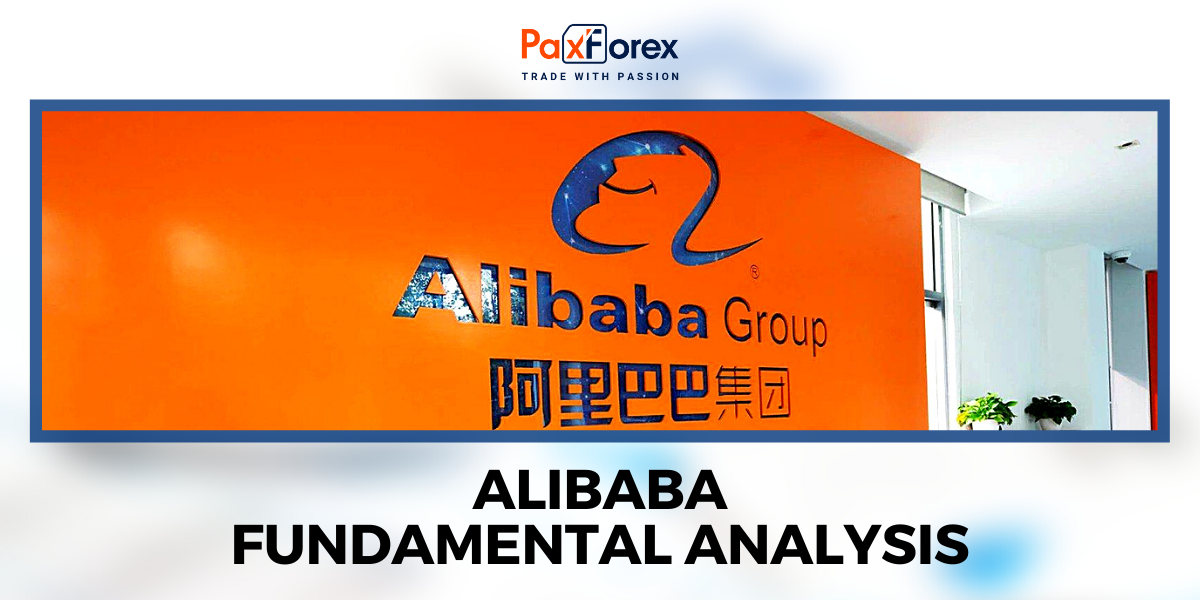
Source: PaxForex Premium Analytics Portal, Fundamental Insight
Alibaba was previously regarded as a promising investment opportunity tied to China's extensive growth prospects. It boasted ownership of Taobao and Tmall, the nation's leading e-commerce platforms, as well as Alibaba Cloud, the largest public cloud infrastructure platform in the cou
Having once been a darling of Wall Street, Alibaba has turned into a troublesome entity for investors in recent years. A sequence of setbacks, including the cancellation of Ant Group's IPO and subdued growth, has pushed Alibaba's stock into a downward spiral, plummeting by over 70% from its pinnacle of $317 per share.
In response to the present predicament, Alibaba is executing a substantial corporate overhaul, fragmenting itself into six distinct units. However, the company still possesses ample room for further actions, essential for steering the ship toward a course correction. In this article, we will delve into two critical domains that Alibaba must confront to reestablish investors' confidence. Emerging as an e-commerce venture, Alibaba's growth trajectory has extended both vertically and horizontally over time, encompassing diverse sectors such as logistics, fintech, entertainment, cloud computing, and more.
While many investors applaud Alibaba's diversified business model, the pivotal point remains: e-commerce remains the unequivocal core of the conglomerate (and will likely retain this status for the foreseeable future). In the fiscal year ending on March 31, 2023, Alibaba's Chinese e-commerce operations contributed a substantial 67% of the company's revenue. Moreover, this very segment accounted for the entirety of Alibaba's profits during that year, as the other segments reported losses.
Inevitably, Alibaba remains predominantly rooted in Chinese e-commerce, unveiling a challenge. The flagship enterprise, led by Tmall and Taobao, encountered a 1% drop in revenue over the last fiscal year. While pandemic-induced lockdowns in China did present challenges, the ascent of contenders like Pinduoduo and Douyin has also intensified pressure on the incumbent. Alibaba is pressed to embark on a transformational journey before the situation exacerbates.
To counter this, Alibaba has initiated a reorganization of its structure, segmenting its empire into six distinct units. This strategic shift empowers each business division with dedicated management, fostering heightened operational efficiency. The objective entails greater adaptability to market dynamics, expeditious and improved decision-making, and a more compelling incentive framework. Ultimately, this endeavor aspires to resurrect the entrepreneurial zeal that Alibaba urgently requires for revitalization.
While it's still in the early stages, investors must grant the company several quarters to assess the efficacy of the newly constituted teams. The e-commerce segment must manifest its capacity to rekindle growth momentum in the upcoming quarters and ideally expand at a pace that meets or surpasses industry growth rates. The trajectory ahead is intriguing as Alibaba strives to realign itself and recapture its competitive edge.
Amid Alibaba's steadfast focus on operational excellence, the realm of capital allocation emerges as another pivotal terrain warranting the company's attention. This facet profoundly influences its growth trajectory, profitability, and the value it crafts for stakeholders.
Historically, Alibaba's capital allocation strategy centered on channeling profits from its robust e-commerce pillar into nascent, high-growth yet unprofitable domains like cloud computing and logistics. However, with the emancipation of its subsidiaries, each unit now wields the autonomy to secure funding autonomously, notably alleviating the e-commerce segment's burden.
As Alibaba's surplus cash flow beckons for strategic redirection, the opportunity to refine its e-commerce domain and bolster shareholder value becomes paramount. This involves judiciously deploying capital in pivotal avenues such as marketing initiatives and research and development endeavors, thereby augmenting the competitiveness of its e-commerce operations.
Furthermore, the potential for sustained or amplified share repurchase endeavors presents itself, particularly as the company's stock hovers near historically low valuations. Additionally, adopting a dividend policy to dispense surplus funds back to shareholders warrants contemplation. While embarking on fresh business ventures is conceivable, a meticulous, discerning approach is imperative.
In essence, Alibaba stands poised to engender substantial shareholder value by navigating its capital allocation endeavors adeptly. This sphere merits vigilant scrutiny from investors, for the potential impact is profound and far-reaching.
Once the cornerstone of China's tech landscape, Alibaba's path has taken a detour due to a sequence of errors, including contentious encounters with Chinese authorities, and a slew of external hurdles that have eroded investor confidence.
However, the horizon is far from bleak. Alibaba still holds sway over some of China's premier business domains. The remedy lies in honing these enterprises to offer enduring value to all stakeholders. Already in motion through recent corporate restructuring, the company is charting a course toward rejuvenation. Patience is the virtue required as investors await the fruits of this turnaround endeavor.
With a restoration of ailing operations and a more judicious approach to capital allocation, Alibaba's renaissance seems within reach. The narrative could well return to its resplendent days of yore, provided the focus remains on nurturing and harnessing its remarkable business franchises.
.
As long as the price is above 90.00, follow the recommendations below:
- Time frame: D1
- Recommendation: long position
- Entry point: 94.60
- Take Profit 1: 102.00
- Take Profit 2: 109.00
Alternative scenario:
If the level of 90.00 is broken-down, follow the recommendations below:
- Time frame: D1
- Recommendation: short position
- Entry point: 90.00
- Take Profit 1: 85.00
- Take Profit 2: 79.00













